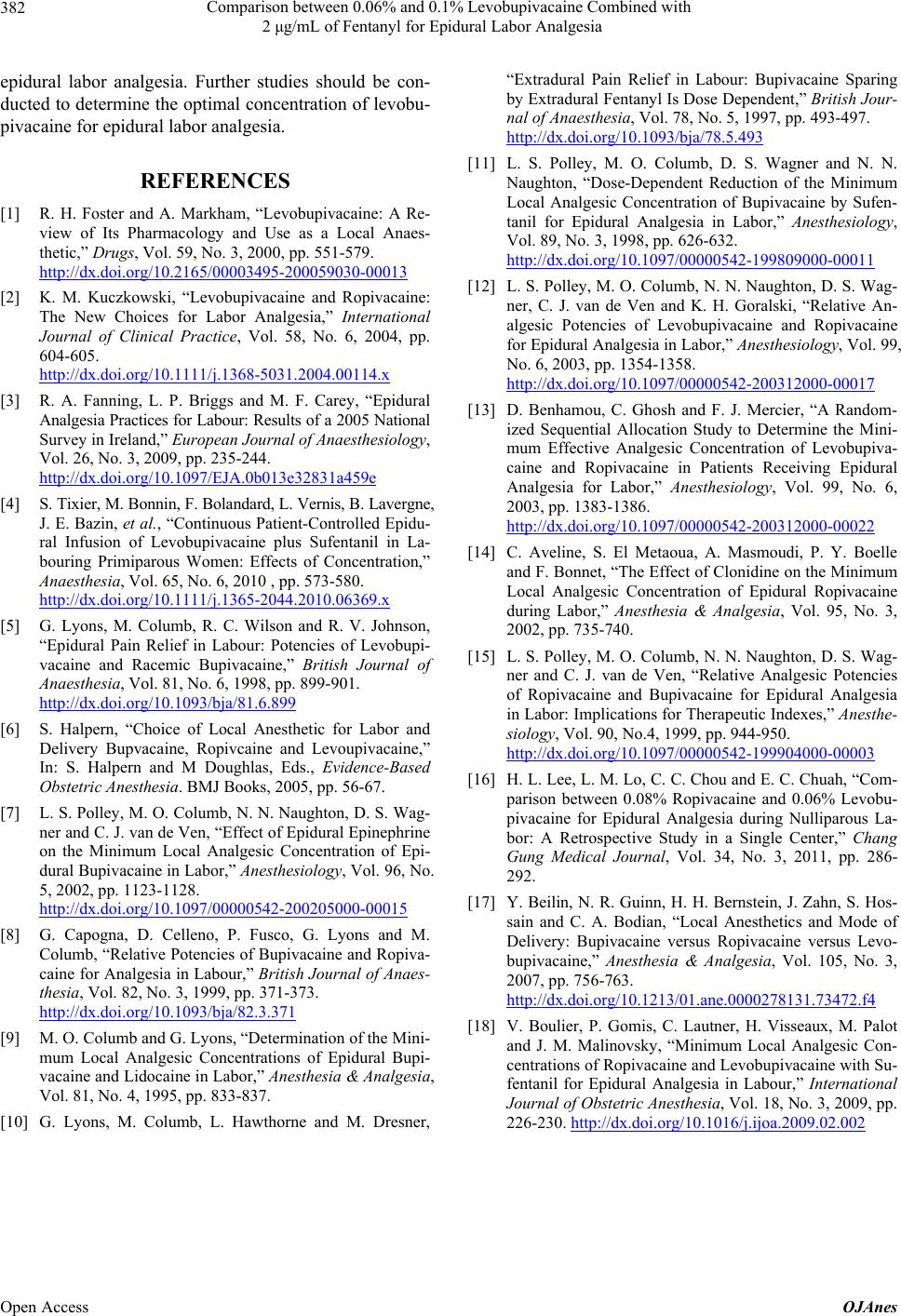
Comparison between 0.06% and 0.1% Levobupivacaine Combined with
2 μg/mL of Fentanyl for Epidural Labor Analgesia
Open Access OJAnes
382
epidural labor analgesia. Further studies should be con-
ducted to determine the optimal concentration of levobu-
pivacaine for epidural labor analgesia.
REFERENCES
[1] R. H. Foster and A. Markham, “Levobupivacaine: A Re-
view of Its Pharmacology and Use as a Local Anaes-
thetic,” Drugs, Vol. 59, No. 3, 2000, pp. 551-579.
http://dx.doi.org/10.2165/00003495-200059030-00013
[2] K. M. Kuczkowski, “Levobupivacaine and Ropivacaine:
The New Choices for Labor Analgesia,” International
Journal of Clinical Practice, Vol. 58, No. 6, 2004, pp.
604-605.
http://dx.doi.org/10.1111/j.1368-5031.2004.00114.x
[3] R. A. Fanning, L. P. Briggs and M. F. Carey, “Epidural
Analgesia Practices for Labour: Results of a 2005 National
Survey in Ireland,” European Journal of Anaesthesiology,
Vol. 26, No. 3, 2009, pp. 235-244.
http://dx.doi.org/10.1097/EJA.0b013e32831a459e
[4] S. Tixier, M. Bonnin, F. Bolandard, L. Vernis, B. Lavergne,
J. E. Bazin, et al., “Continuous Patient-Controlled Epidu-
ral Infusion of Levobupivacaine plus Sufentanil in La-
bouring Primiparous Women: Effects of Concentration,”
Anaesthesia, Vol. 65, No. 6, 2010 , pp. 573-580.
http://dx.doi.org/10.1111/j.1365-2044.2010.06369.x
[5] G. Lyons, M. Columb, R. C. Wilson and R. V. Johnson,
“Epidural Pain Relief in Labour: Potencies of Levobupi-
vacaine and Racemic Bupivacaine,” British Journal of
Anaesthesia, Vol. 81, No. 6, 1998, pp. 899-901.
http://dx.doi.org/10.1093/bja/81.6.899
[6] S. Halpern, “Choice of Local Anesthetic for Labor and
Delivery Bupvacaine, Ropivcaine and Levoupivacaine,”
In: S. Halpern and M Doughlas, Eds., Evidence-Based
Obstetric Anesthesia. BMJ Books, 2005, pp. 56-67.
[7] L. S. Polley, M. O. Columb, N. N. Naughton, D. S. Wag-
ner and C. J. van de Ven, “Effect of Epidural Epinephrine
on the Minimum Local Analgesic Concentration of Epi-
dural Bupivacaine in Labor,” Anesthesiology, Vol. 96, No.
5, 2002, pp. 1123-1128.
http://dx.doi.org/10.1097/00000542-200205000-00015
[8] G. Capogna, D. Celleno, P. Fusco, G. Lyons and M.
Columb, “Relative Potencies of Bupivacaine and Ropiva-
caine for Analgesia in Labour,” British Journal of Anaes-
thesia, Vol. 82, No. 3, 1999, pp. 371-373.
http://dx.doi.org/10.1093/bja/82.3.371
[9] M. O. Columb and G. Lyons, “Determination of the Mini-
mum Local Analgesic Concentrations of Epidural Bupi-
vacaine and Lidocaine in Labor,” Anesthesia & Analgesia,
Vol. 81, No. 4, 1995, pp. 833-837.
[10] G. Lyons, M. Columb, L. Hawthorne and M. Dresner,
“Extradural Pain Relief in Labour: Bupivacaine Sparing
by Extradural Fentanyl Is Dose Dependent,” British Jour-
nal of Anaesthesia, Vol. 78, No. 5, 1997, pp. 493-497.
http://dx.doi.org/10.1093/bja/78.5.493
[11] L. S. Polley, M. O. Columb, D. S. Wagner and N. N.
Naughton, “Dose-Dependent Reduction of the Minimum
Local Analgesic Concentration of Bupivacaine by Sufen-
tanil for Epidural Analgesia in Labor,” Anesthesiology,
Vol. 89, No. 3, 1998, pp. 626-632.
http://dx.doi.org/10.1097/00000542-199809000-00011
[12] L. S. Polley, M. O. Columb, N. N. Naughton, D. S. Wag-
ner, C. J. van de Ven and K. H. Goralski, “Relative An-
algesic Potencies of Levobupivacaine and Ropivacaine
for Epidural Analgesia in Labor,” Anesthesiology, Vol. 99,
No. 6, 2003, pp. 1354-1358.
http://dx.doi.org/10.1097/00000542-200312000-00017
[13] D. Benhamou, C. Ghosh and F. J. Mercier, “A Random-
ized Sequential Allocation Study to Determine the Mini-
mum Effective Analgesic Concentration of Levobupiva-
caine and Ropivacaine in Patients Receiving Epidural
Analgesia for Labor,” Anesthesiology, Vol. 99, No. 6,
2003, pp. 1383-1386.
http://dx.doi.org/10.1097/00000542-200312000-00022
[14] C. Aveline, S. El Metaoua, A. Masmoudi, P. Y. Boelle
and F. Bonnet, “The Effect of Clonidine on the Minimum
Local Analgesic Concentration of Epidural Ropivacaine
during Labor,” Anesthesia & Analgesia, Vol. 95, No. 3,
2002, pp. 735-740.
[15] L. S. Polley, M. O. Columb, N. N. Naughton, D. S. Wag-
ner and C. J. van de Ven, “Relative Analgesic Potencies
of Ropivacaine and Bupivacaine for Epidural Analgesia
in Labor: Implications for Therapeutic Indexes,” Anesthe-
siology, Vol. 90, No.4, 1999, pp. 944-950.
http://dx.doi.org/10.1097/00000542-199904000-00003
[16] H. L. Lee, L. M. Lo, C. C. Chou and E. C. Chuah, “Com-
parison between 0.08% Ropivacaine and 0.06% Levobu-
pivacaine for Epidural Analgesia during Nulliparous La-
bor: A Retrospective Study in a Single Center,” Chang
Gung Medical Journal, Vol. 34, No. 3, 2011, pp. 286-
292.
[17] Y. Beilin, N. R. Guinn, H. H. Bernstein, J. Zahn, S. Hos-
sain and C. A. Bodian, “Local Anesthetics and Mode of
Delivery: Bupivacaine versus Ropivacaine versus Levo-
bupivacaine,” Anesthesia & Analgesia, Vol. 105, No. 3,
2007, pp. 756-763.
http://dx.doi.org/10.1213/01.ane.0000278131.73472.f4
[18] V. Boulier, P. Gomis, C. Lautner, H. Visseaux, M. Palot
and J. M. Malinovsky, “Minimum Local Analgesic Con-
centrations of Ropivacaine and Levobupivacaine with Su-
fentanil for Epidural Analgesia in Labour,” International
Journal of Obstetric Anesthesia, Vol. 18, No. 3, 2009, pp.
226-230. http://dx.doi.org/10.1016/j.ijoa.2009.02.002